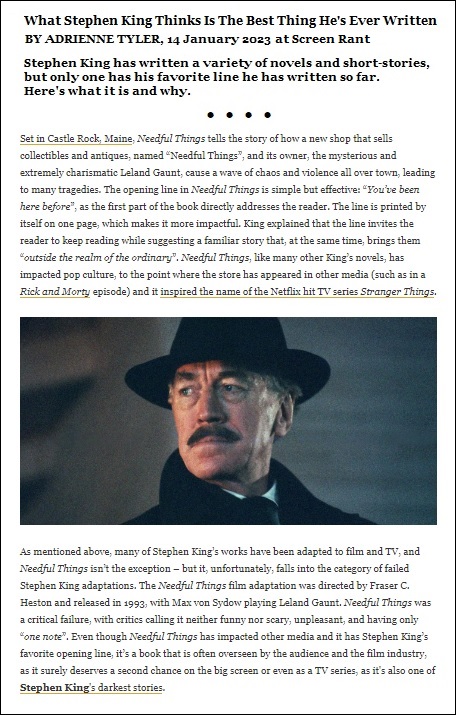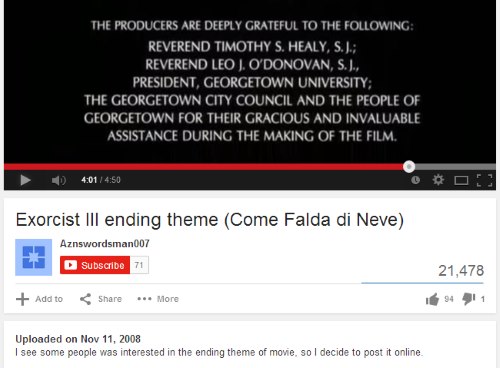A Log24 search suggested by a webpage*
of the World Economic Forum (the Davos group) —
Sunday, July 16, 2017
Snow Mann
Tuesday, February 26, 2013
Snow
"Hans Castorp is a searcher after the Holy Grail.
You would never have thought it when you read
his story—if I did myself, it was both more and
less than thinking. Perhaps you will read the
book again from this point of view. And perhaps
you will find out what the Grail is: the knowledge
and the wisdom, the consecration, the highest
reward, for which not only the foolish hero but
the book itself is seeking. You will find it in the
chapter called 'Snow'…."
— Thomas Mann, "The Making of
The Magic Mountain "
In related entertainment news…
Click image for some backstory.
Mann's tale is set in Davos, Switzerland.
See also Mayer at Davos.
Sunday, January 15, 2023
Fire and Ice
Organic Symmetry
"Benzene is a natural constituent of petroleum
and is one of the elementary petrochemicals.
Due to the cyclic continuous pi bonds between
the carbon atoms, benzene is classed as an
aromatic hydrocarbon. Benzene is a colorless
and highly flammable liquid with a sweet smell,
and is partially responsible for the aroma of gasoline."
Anti-Organic Symmetry —
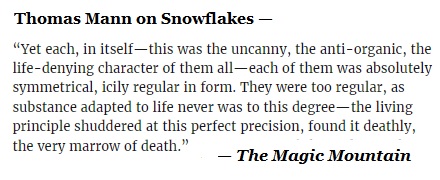
Monday, January 26, 2015
Ending Credits
From a search for "snowflake" in this journal —
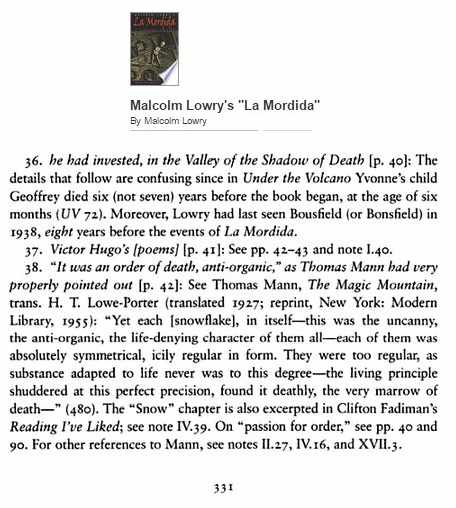
See also the January 13 death of a mathematician,
graph theorist Ralph Faudree of the University of Memphis.
Two hymns that may or may not be relevant:
Walking in Memphis and Come Falda di Neve,
the song that plays over the ending credits of
Exorcist III —

†
Those who prefer more-secular music may consult
Princeton Requiem, a post from the day of Faudree's death.
Sunday, November 30, 2014
View from the Bottom
Reality's Mirror: Exploring the Mathematics of Symmetry —
"Here is a book that explains in laymen language
what symmetry is all about, from the lowliest snowflake
and flounder to the lofty group structures whose
astonishing applications to the Old One are winning
Nobel prizes. Bunch's book is a marvel of clear, witty
science writing, as delightful to read as it is informative
and up-to-date. The author is to be congratulated on
a job well done." — Martin Gardner
"But, sweet Satan, I beg of you, a less blazing eye!"
— Rimbaud, A Season in Hell
"… the lowliest snowflake and flounder…."
— Martin Gardner


Investments
From "A Piece of the Storm," by the late poet Mark Strand —
A snowflake, a blizzard of one….
From notes to Malcolm Lowry's "La Mordida" —
he had invested, in the Valley of the Shadow of Death….
See also Weyl's Symmetry in this journal.
Wednesday, January 22, 2014
A Riddle for Davos
Einstein and Thomas Mann, Princeton, 1938
See also the life of Diogenes Allen, a professor at Princeton
Theological Seminary, a life that reportedly ended on the date—
January 13, 2013— of the above Log24 post.
January 13 was also the dies natalis of St. James Joyce.
Some related reflections —

"Praeterit figura huius mundi " — I Corinthians 7:31 —

|
Conclusion of of "The Dead," by James Joyce— The air of the room chilled his shoulders. He stretched himself cautiously along under the sheets and lay down beside his wife. One by one, they were all becoming shades. Better pass boldly into that other world, in the full glory of some passion, than fade and wither dismally with age. He thought of how she who lay beside him had locked in her heart for so many years that image of her lover's eyes when he had told her that he did not wish to live. Generous tears filled Gabriel's eyes. He had never felt like that himself towards any woman, but he knew that such a feeling must be love. The tears gathered more thickly in his eyes and in the partial darkness he imagined he saw the form of a young man standing under a dripping tree. Other forms were near. His soul had approached that region where dwell the vast hosts of the dead. He was conscious of, but could not apprehend, their wayward and flickering existence. His own identity was fading out into a grey impalpable world: the solid world itself, which these dead had one time reared and lived in, was dissolving and dwindling. A few light taps upon the pane made him turn to the window. It had begun to snow again. He watched sleepily the flakes, silver and dark, falling obliquely against the lamplight. The time had come for him to set out on his journey westward. Yes, the newspapers were right: snow was general all over Ireland. It was falling on every part of the dark central plain, on the treeless hills, falling softly upon the Bog of Allen and, farther westward, softly falling into the dark mutinous Shannon waves. It was falling, too, upon every part of the lonely churchyard on the hill where Michael Furey lay buried. It lay thickly drifted on the crooked crosses and headstones, on the spears of the little gate, on the barren thorns. His soul swooned slowly as he heard the snow falling faintly through the universe and faintly falling, like the descent of their last end, upon all the living and the dead. |
Thursday, November 29, 2012
Lines of Symbols
C. P. Snow on G. H. Hardy, in Snow's foreword to A Mathematician's Apology—
"One morning early in 1913, he found, among the letters on his breakfast table, a large untidy envelope decorated with Indian stamps. When he opened it, he found sheets of paper by no means fresh, on which, in a non-English holograph, were line after line of symbols. Hardy glanced at them without enthusiasm. He was by this time, at the age of thirty-six, a world famous mathematician: and world famous mathematicians, he had already discovered, are unusually exposed to cranks. He was accustomed to receiving manuscripts from strangers, proving the prophetic wisdom of the Great Pyramid, the revelations of the Elders of Zion, or the cryptograms that Bacon has inserted in the plays of the so-called Shakespeare."
Some related material (click to enlarge)—
The author links to, but does not name, the source of the above
"line after line of symbols." It is "Visualizing GL(2,p)." See that webpage
for some less esoteric background.
See also the two Wikipedia articles Finite geometry and Hesse configuration
and an image they share—
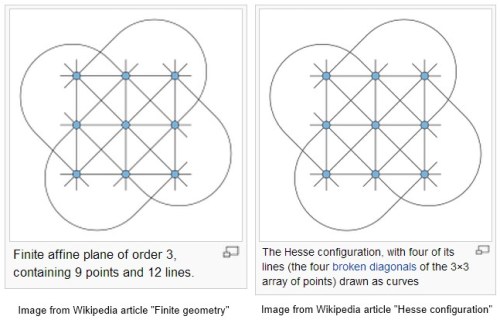
Saturday, September 19, 2009
Saturday September 19, 2009
Slouching
Towards Kristen
|
Jerusalem Post Interview by Hilary Leilea Krieger, JPost Correspondent, Washington Krauthammer, a columnist for The Washington Post, is a winner of the Irving Kristol award. Jerusalem Post, June 10, 2009: Can you talk a little bit about your own Jewish upbringing and sense of Jewishness, and how that influences you? I assume it’s a factor in this particular project. I grew up in a Modern Orthodox home [in Montreal]. I went to Jewish day school right through high school, so half of my day was spent speaking Hebrew from age six to 16. I studied thousands of hours of Talmud. My father thought I didn’t get enough Talmud at school, so I took the extra Talmud class at school and he had a rabbi come to the house three nights a week. One of those nights was Saturday night, so in synagogue Saturday morning my brother and I would pray very hard for snow so he wouldn’t be able to come on Saturday night and we could watch hockey night in Canada. That’s where I learned about prayer. That didn’t seem to you to be a prayer that was likely to go unanswered? Yeah, I was giving it a shot to see what side God was on. And what did you determine? It rarely snowed. ************************************ More on Krauthammer’s Canadian childhood: “His parents were Orthodox and sent him to — “Charles Krauthammer: Prize Writer,” ************************************ Also in the Jerusalem Post interview: …. What, then, did you mean by a Jewish sensibility? “…. In literature it’s an interesting question, what’s a Jewish novel?” |
My Prayer:
Private Gomorrah lessons
with Kristen.
Background:
“Heaven Can Wait”
at Haaretz.com
Happy Rosh Hashanah
(and Gemara).
Update, 5:01 AM Sept. 19
Before becoming a writer,
Krauthammer was, his
Washington Post biography says,
a resident and then chief resident
in psychiatry at
Massachusetts General Hospital.
Related Metaphors
This morning’s New York Times:

MicheleBachmann.com this morning:
See also:
James Hillman’s “acorn theory“
of personality development
(yesterday’s entry).
Wednesday, July 15, 2009
Wednesday July 15, 2009
of obituaries page,
New York Times,
Monday morning:

| Detail of arts page, New York Times, Wednesday morning: (Click ad for more on the Monday night death of Dash Snow.) |
Hurt yet?
_________________
Update of 5:01 AM:
Lavery Hits
Literary Jackpot
From the top right of
this morning's online
New York Times front page:
Click on voodoo doll
for further details.
See also…
1. Monday's link to a
Wallace Stevens poem,
"Snow and Stars"
2. The conclusion of this
morning's Times obituary
for artist Dash Snow, which
gives his daughter's name…
"Secret."
3. David Lavery's excellent
analysis of the classic
Conrad Aiken story
"Silent Snow, Secret Snow."
Sunday, May 25, 2008
Sunday May 25, 2008
— Song lyric, Cyndi Lauper
Magister Ludi
Hermann Hesse's 1943 The Glass Bead Game (Picador paperback, Dec. 6, 2002, pp. 139-140)–
"For the present, the Master showed him a bulky memorandum, a proposal he had received from an organist– one of the innumerable proposals which the directorate of the Game regularly had to examine. Usually these were suggestions for the admission of new material to the Archives. One man, for example, had made a meticulous study of the history of the madrigal and discovered in the development of the style a curved that he had expressed both musically and mathematically, so that it could be included in the vocabulary of the Game. Another had examined the rhythmic structure of Julius Caesar's Latin and discovered the most striking congruences with the results of well-known studies of the intervals in Byzantine hymns. Or again some fanatic had once more unearthed some new cabala hidden in the musical notation of the fifteenth century. Then there were the tempestuous letters from abstruse experimenters who could arrive at the most astounding conclusions from, say, a comparison of the horoscopes of Goethe and Spinoza; such letters often included pretty and seemingly enlightening geometric drawings in several colors."
A Bulky Memorandum
From Siri Hustvedt, author of Mysteries of the Rectangle: Essays on Painting (Princeton Architectural Press, 2005)– What I Loved: A Novel (Picador paperback, March 1, 2004, page 168)–
A description of the work of Bill Wechsler, a fictional artist:
"Bill worked long hours on a series of autonomous pieces about numbers. Like O's Journey, the works took place inside glass cubes, but these were twice as large– about two feet square. He drew his inspiration from sources as varied as the Cabbala, physics, baseball box scores, and stock market reports. He painted, cut, sculpted, distorted, and broke the numerical signs in each work until they became unrecognizable. He included figures, objects, books, windows, and always the written word for the number. It was rambunctious art, thick with allusion– to voids, blanks, holes, to monotheism and the individual, the the dialectic and yin-yang, to the Trinity, the three fates, and three wishes, to the golden rectangle, to seven heavens, the seven lower orders of the sephiroth, the nine Muses, the nine circles of Hell, the nine worlds of Norse mythology, but also to popular references like A Better Marriage in Five Easy Lessons and Thinner Thighs in Seven Days. Twelve-step programs were referred to in both cube one and cube two. A miniature copy of a book called The Six Mistakes Parents Make Most Often lay at the bottom of cube six. Puns appeared, usually well disguised– one, won; two, too, and Tuesday; four, for, forth; ate, eight. Bill was partial to rhymes as well, both in images and words. In cube nine, the geometric figure for a line had been painted on one glass wall. In cube three, a tiny man wearing the black-and-white prison garb of cartoons and dragging a leg iron has
— End of page 168 —
opened the door to his cell. The hidden rhyme is "free." Looking closely through the walls of the cube, one can see the parallel rhyme in another language: the German word drei is scratched into one glass wall. Lying at the bottom of the same box is a tiny black-and-white photograph cut from a book that shows the entrance to Auschwitz: ARBEIT MACHT FREI. With every number, the arbitrary dance of associations worked togethere to create a tiny mental landscape that ranged in tone from wish-fulfillment dream to nightmare. Although dense, the effect of the cubes wasn't visually disorienting. Each object, painting, drawing, bit of text, or sculpted figure found its rightful place under the glass according to the necessary, if mad, logic of numerical, pictorial, and verbal connection– and the colors of each were startling. Every number had been given a thematic hue. Bill had been interested in Goethe's color wheel and in Alfred Jensen's use of it in his thick, hallucinatory paintings of numbers. He had assigned each number a color. Like Goethe, he included black and white, although he didn't bother with the poet's meanings. Zero and one were white. Two was blue. Three was red, four was yellow, and he mixed colors: pale blue for five, purples in six, oranges in seven, greens in eight, and blacks and grays in nine. Although other colors and omnipresent newsprint always intruded on the basic scheme, the myriad shades of a single color dominated each cube.
The number pieces were the work of a man at the top of his form. An organic extension of everything Bill had done before, these knots of symbols had an explosive effect. The longer I looked at them, the more the miniature constructions seemed on the brink of bursting from internal pressure. They were tightly orchestrated semantic bombs through which Bill laid bare the arbitrary roots of meaning itself– that peculiar social contract generated by little squiggles, dashes, lines, and loops on a page."
(named not for
Bill Wechsler, the
fictional artist above,
but for the non-fictional
David Wechsler) –
|
From 2002:
Above: Dr. Harrison Pope, Harvard professor of psychiatry, demonstrates the use of the Wechsler Adult Intelligence Scale "block design" subtest. |
A Magic Gallery
|
ZZ
Figures from the
Poem by Eugen Jost:
Mit Zeichen und Zahlen
Numbers and Names,
With numbers and names English translation A related poem:
Alphabets
From time to time
But if a savage
— Hermann Hesse (1943), |
Sunday, July 29, 2007
Sunday July 29, 2007
| Nordic Truth: | Jewish Fiction: |
| Snowball | In Hell |
| From The New York Times in 2005:
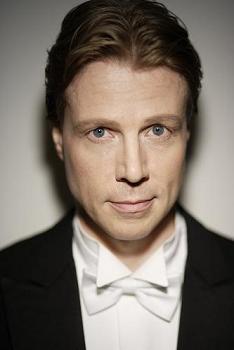 “HE’S the hottest conductor you’ve never heard of…. In music, as in most other pursuits, one person’s misfortune can be another’s opportunity. Many a podium career has been built on successful substitutions…. typically, the process is cumulative and measured. In Mr. Remmereit’s case, it seems a sort of spontaneous combustion…. he seems destined for big things, and soon. Regarding his sudden change in stature, he spoke as if from afar. ‘The snowball has reached such a size that it has started to roll,’ he said matter-of-factly…. ‘It’s terrifying when it happens,’ he said, ‘but I can’t tell you how naively happy I am when it goes well. These are such major steps that I wasn’t even hoping for a few weeks ago.’ ARILD REMMEREIT (pronounced AHR-eeld REMM-uh-right, with the r’s heavily rolled) was born in a village in Norway, between Bergen and Trondheim, and has lived in Vienna since 1987. Slim and fresh-faced at 43, he has had a busy but low-level career in Europe…. So here he was, on April 15, conducting the Pittsburgh Symphony… in a vintage… Germanic program…. Wagner’s ‘Siegfried Idyll,’ Schumann’s Fourth Symphony and Brahms’s Second Piano Concerto….” Württemberg Philharmonic February 2004 Arild Remmereit as a guest conductor: ‘As when the sun rises in the North.’ The Philharmonics and their brilliant guest conductor fetched the mind-blowing, tempting and exciting Scandinavia. It was like a lucky strike to see the Norwegian conductor on stage with the Philharmonic. When he conducts the Dane Nielsen, the Finn Sibelius and the Norwegian Grieg, one can really feel that this man has the locally marked music floating in his blood.” |
From The New York Times today: Discussion of
a new novel: 
Variations on An interview with Henry Grinberg conducted by James R. Oestreich: “For those who find inspiration and edification in great art, it is always painful to be reminded that artists are not necessarily admirable as people and that art is powerless in the face of great evil. That truth was baldly evident in Nazi Germany and in the way the regime used and abused music and musicians, to say nothing of the way it used and abused human beings of all kinds. [A new novel touches on] these issues…. In Variations on the Beast (Dragon Press), Henry Grinberg, a psychoanalyst, posits Hermann Kapp-Dortmunder, a powerful maestro, as a fictional rival of Wilhelm Furtwängler (whose qualms about working under the regime he does not share) and Herbert von Karajan (whose vaulting ambition he does).” GRINBERG: “And it soon occurred to me… that, my God, a lot of the famous, the notable, the moving, the magnificent composers in the 18th and 19th centuries and earlier were Germans. And I tried to understand, how did such a nation turn out to be so bestial and cruel, so indifferent to the suffering of others? And I have no explanation for it. As a practicing psychoanalyst, I can see individual expressions of rage and their causes and their so-called justifications. But for a whole nation to be consumed, to be seduced by an overwhelming idea– well, there are rationalizations, I guess, but not explanations. There’s no forgiveness for this. And I tried to put together a story of a person who was a participant and a causer of these kinds of things…. So I sort of poured my feelings of contempt and rage into the character I was devising. And I have to admit, after having been psychoanalyzed myself in preparation for the training, that something of Hermann Kapp-Dortmunder exists in me. I shudder to think that this may be so, but I have to accept the possibility. Murderous thoughts may have occurred to me, but, thank God, I’ve never killed anyone.” |
Sunday, December 24, 2006
Sunday December 24, 2006
(in memory of George Latshaw,
who died on Tuesday, Dec. 19, 2006)
|
Brightness Doubled Seven is Heaven “Love is the shadow Witness the man who — Roger Waters, quoted in |
“At Home in Landscape:
Mannheim’s Chiliastic Mentality
in ‘Tintern Abbey’“
Garrett comments on Wordsworth’s approach to landscape, citing Karl Mannheim, Ideology and Utopia, translated by Louis Wirth and Edward Shils (page numbers below refer to the 1998 Routledge edition):
“… ‘the present becomes the breach through which what was previously inward, bursts out suddenly, takes hold of the outer world and transforms it’ [p. 193]. This breaking through into ecstasy can only be brought about through ‘Kairos‘ or ‘fulfilled time'”….
See translators’ note, p. 198: “In Greek mythology Kairos is the God of Opportunity– the genius of the decisive moment. The Christianized notion of this is given thus in Paul Tillich‘s The Religious Situation [1925, translation by H. Richard Niebuhr, New York, Holt, 1932, pp. 138-139]: ‘Kairos is fulfilled time, the moment of time which is invaded by eternity. But Kairos is not perfection or completion in time.'”
Garrett quotes Wordsworth’s 1850 Prelude:
There are in our existence spots of time,
That with distinct pre-eminence retain
A renovating virtue … (12.208-210)
“And in book 14 Wordsworth…. symbolizes how man can find transcendent unity with the universe through the image of himself leading his group to the peak of Mt. Snowdon. Climbing at night in thick fog, he almost steps off a cliff, but at the last instant, he steps out of the mist, the moon appears, and his location on the brink is revealed. Walking in the darkness of reason, his imagination illumed the night, revealed the invisible world, and spared him his life.”
See also Charles Frazier on the edge of eternity:
“They climbed to a bend and from there they walked on great slabs of rock. It seemed to Inman that they were at the lip of a cliff, for the smell of the thin air spoke of considerable height, though the fog closed off all visual check of loftiness…. Then he looked back down and felt a rush of vertigo as the lower world was suddenly revealed between his boot toes. He was indeed at the lip of a cliff, and he took one step back….”
From Log24 on 7/15, 2005:
Christopher Fry’s obituary
in The New York Times—
“His plays radiated
an optimistic faith in God
and humanity, evoking,
in his words, ‘a world
in which we are poised
on the edge of eternity,
a world which has
deeps and shadows
of mystery,
and God is anything but
a sleeping partner.'”
Accompanying illustration:

Adapted from cover of
German edition of Cold Mountain
Tuesday, May 23, 2006
Tuesday May 23, 2006
continued
Exhibit A:
A science vulgarizer in today’s New York Times–
“Somewhere out there, more elusive than a snow leopard, more vaunted in its imagined cultural oomph than an Oprah book blurb, is the Science Movie.
You know, the film that finally does for science and scientists what ‘The Godfather’ did for crime and what ‘The West Wing’ did for politics, accurately reproducing the grandeur and grit of science while ushering its practitioners into the ranks of coolness.”
Exhibit B:
John Updike’s review in the May 22 New Yorker of a new novel by Michel Houellebecq, The Possibility of an Island—
“Nor is Houellebecq…. entirely without literary virtue. His four novels– Whatever (1994), The Elementary Particles (1998), and Platform (2001) are the three others– display a grasp of science and mathematics beyond that of all but a few non-genre novelists.”
A character in the new novel– “a lengthy exercise in futuristic science fiction”– writes that
“The dream of all men is to meet little sluts who are innocent but ready for all forms of depravity– which is what, more or less, all teenage girls are.”
Exhibit C:
A mathematician hopes for more exciting vulgarizations of his subject–
“I would hope that clever writers might point out how mathematics is altering our lifestyles and do it in a manner that would not lead Garfield the Cat to say ‘ho hum.'”
— Philip J. Davis, “The Media and Mathematics Look at Each Other” (pdf), Notices of the American Mathematical Society, March 2006
Exhibit D:
Today’s Garfield—

Exhibit E:
Log24 entry of May 18, a parody of “Contact,” a 1997 film that vulgarized science–
“They should have
sent a poet.”

Exhibit F:
Gilbert and Sullivan, “The Mikado“–
“(With great effort) How de do, little girls, how de do? (Aside) Oh, my protoplasmal ancestor!”
Coda“It might be asking too much
to make us cool.”
— Science vulgarizer
Dennis Overbye
Robert De Niro as the
young Vito Corleone
Thursday, March 4, 2004
Thursday March 4, 2004
ZZ
we measure heaven and earth
black
on white
we create new worlds
and universes

“Numbers and Names,
Wording and Words”
by Eugen Jost
Alphabets
From time to time we take our pen in hand
And scribble symbols on a blank white sheet
Their meaning is at everyone’s command;
It is a game whose rules are nice and neat.
But if a savage or a moon-man came
And found a page, a furrowed runic field,
And curiously studied lines and frame:
How strange would be the world that they revealed.
A magic gallery of oddities.
He would see A and B as man and beast,
As moving tongues or arms or legs or eyes,
Now slow, now rushing, all constraint released,
Like prints of ravens’ feet upon the snow.
He’d hop about with them, fly to and fro,
And see a thousand worlds of might-have-been
Hidden within the black and frozen symbols,
Beneath the ornate strokes, the thick and thin.
He’d see the way love burns and anguish trembles,
He’d wonder, laugh, shake with fear and weep
Because beyond this cipher’s cross-barred keep
He’d see the world in all its aimless passion,
Diminished, dwarfed, and spellbound in the symbols,
And rigorously marching prisoner-fashion.
He’d think: each sign all others so resembles
That love of life and death, or lust and anguish,
Are simply twins whom no one can distinguish …
Until at last the savage with a sound
Of mortal terror lights and stirs a fire,
Chants and beats his brow against the ground
And consecrates the writing to his pyre.
Perhaps before his consciousness is drowned
In slumber there will come to him some sense
Of how this world of magic fraudulence,
This horror utterly behind endurance,
Has vanished as if it had never been.
He’ll sigh, and smile, and feel all right again.
— Hermann Hesse (1943),
“Buchstaben” from Das Glasperlenspiel,
translated by Richard and Clara Winston
See also the previous entry,
on the dream
of El Pato-lógico.
Saturday, August 9, 2003
Saturday August 9, 2003
Bibles
Today is the feast day of St. Hermann Hesse. A quotation from a work by Hesse that is to some a sort of Bible:
"You treat world history as a mathematician does mathematics, in which nothing but laws and formulae exist, no reality, no good and evil, no time, no yesterday, no tomorrow, nothing but an eternal, shallow, mathematical present."
— Father Jacobus, Benedictine priest, in The Glass Bead Game, ch. 4 (1943, translated 1960), by Hermann Hesse
A Benedictine Archbishop's Apology:
"Archbishop Weakland described his feelings 'at this moment' as 'remorse, contrition, shame and emptiness,' also noting that 'much self-pity and pride remain.' He contended he 'must leave that pride behind.' "
C.P. Snow in his introduction to A Mathematician's Apology (also a Bible, or at least a book of a Bible, to some) quotes G. H. Hardy on hearing the chimes of Vespers:
"It's rather unfortunate that some of the happiest hours of my life should have been spent within sound of a Roman Catholic church.''
A Bible for Benedictines:
The Encyclopedic Dictionary of Mathematics,
by the Mathematical Society of Japan,
is suitable reading for those Benedictines in Purgatory who have too lightly used words like "no reality" and "shallow" to describe mathematics.
For other remedial reading in the afterlife, see Midsummer Eve's Dream and Quine in Purgatory.





